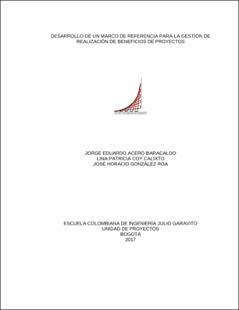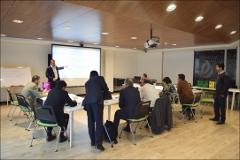Mostrar el registro sencillo del ítem
Desarrollo de un marco de referencia para la gestión de realización de beneficios de proyectos
| dc.contributor.advisor | Buzeta Araya, Rodrigo Javier (dir) | spa |
| dc.contributor.author | Acero Bacaraldo, Jorge Eduardo | spa |
| dc.contributor.author | Coy Calixto, Lina Patricia | spa |
| dc.contributor.author | González Roa, José Horacio | spa |
| dc.date.accessioned | 2017-08-24T23:01:54Z | spa |
| dc.date.accessioned | 2021-10-01T17:12:03Z | |
| dc.date.available | 2017-08-24T23:01:54Z | spa |
| dc.date.available | 2021-10-01T17:12:03Z | |
| dc.date.issued | 2017 | spa |
| dc.identifier.citation | (Acero, Coy, & González, 2017) | spa |
| dc.identifier.uri | http://catalogo.escuelaing.edu.co/cgi-bin/koha/opac-detail.pl?biblionumber=20805 | spa |
| dc.identifier.uri | https://repositorio.escuelaing.edu.co/handle/001/627 | |
| dc.description.abstract | Organizations, regardless of their nature, size and object, seek to create value (not necessarily economic), which is why they define the vision, objectives and goals they want to achieve, as a result of market needs, obligations or requirements. Fulfill, the opportunities to be exploited, the problems they must solve or the particular interests of the investors or the interested parties. This organizational vision and strategic objectives, as well as their raison d'être (mission), make up the strategic planning or strategy of the organization, which together with the tactical and operative objectives are developed through the management or organizational direction of projects and the Routine and permanent operations. The management performed by an organization (projects and operations) seeks to create value for stakeholders, which is composed, on the one hand, of the value of the business and, on the other hand, for the positive impact or benefit that a population receives. Business value is defined as the total value of an organization, that is, the sum of the tangible and intangible elements that comprise it. The positive benefit or impact is the wealth or value that a population perceives through the use or access to a product or service, as well as the experience of a positive change or condition of the environment (public services, health, education, security, public transport Massive), which is derived from the realization of a public investment project, usually by the State or sponsored by the State. This degree work focuses on the management of realization of project benefits, understanding that it is through the management of projects, programs and portfolios, how organizations execute their strategy to achieve better results and competitive advantages in the market or the environment . The bibliographical research allowed to infer that the management of the projects from the different approaches analyzed focuses more on the generation of deliverables, products, services, results or changes, without formally taking care of the realization of benefits, which usually materialize during The phase of operation of the project product. This emphasis does not ensure that the project is successful and is forcing organizations to rethink their indicators as well as how to plan and execute projects that leverage business strategy. On the other hand, when organizations establish programs or portfolios they have a greater focus towards the benefits and the generation of value respectively, however; It is not clear what to do to manage the realization of benefits, in a project that is not part of a program, and is in a portfolio not formally defined. For this reason, the research group proposes as a solution a reference framework for the management of benefit realization of projects that are not part of a program, and are within a portfolio not formally defined. This frame of reference is made up of four processes: identification, planning, realization and sustainability. Also, this document provides a series of tools and templates that facilitate the understanding and appropriation of this complementary practice to the management of projects as it is currently conceived. | eng |
| dc.description.abstract | Las organizaciones, independientemente de su naturaleza, tamaño y objeto, buscan crear valor (no necesariamente económico), razón por la cual definen la visión, los objetivos y las metas que quieren alcanzar, producto de las necesidades del mercado, las obligaciones o requisitos por cumplir, las oportunidades por aprovechar, los problemas que deben resolver o los intereses particulares de los inversionistas o de las partes interesadas. Esa visión organizacional y los objetivos estratégicos, así como su razón de ser (misión), conforman la planeación estratégica o estrategia de la organización, que junto con los objetivos tácticos y operativos se desarrollan a través de la gestión o dirección organizacional de proyectos y las operaciones rutinarias y permanentes. La gestión que realiza una organización (proyectos y operaciones) busca crear valor para las partes interesadas, el cual está compuesto, de una parte, por el valor del negocio y, de otra, por el beneficio o impacto positivo que percibe una población. El valor de negocio se define como el valor total de una organización, es decir, la sumatoria de los elementos tangibles e intangibles que la conforman. El beneficio o impacto positivo es la riqueza o valor que percibe una población a través del uso o acceso a un producto o servicio, así como la vivencia de un cambio positivo o condición del entorno (servicios públicos, salud, educación, seguridad, transporte público masivo), que se deriva de la realización de un proyecto de inversión pública, generalmente a cargo del Estado o patrocinado por éste. Este Trabajo de grado se centra en la gestión de realización de beneficios de proyectos, entendiendo que es a través de la dirección de proyectos, programas y portafolios, como las organizaciones ejecutan su estrategia para lograr mejores resultados y ventajas competitivas en el mercado o el entorno. La investigación bibliográfica permitió inferir que la gestión de los proyectos desde los diferentes enfoques analizados se orienta con mayor énfasis en la generación de entregables, productos, servicios, resultados o cambios, sin ocuparse formalmente de la realización de beneficios, los cuales usualmente se materializan durante la fase de operación del producto del proyecto. Este énfasis no asegura que el proyecto sea exitoso y está obligando a las organizaciones a repensar sus indicadores, así como la forma de planear y ejecutar los proyectos que apalancan la estrategia del negocio. Por otra parte, cuando las organizaciones establecen programas o portafolios tienen un mayor enfoque hacia los beneficios y a la generación de valor respectivamente, sin embargo; no está claro qué hacer para gestionar la realización de beneficios, en un proyecto que no hace parte de un programa, y está en un portafolio no definido formalmente. Por esta razón, el grupo de investigación propone como solución un marco de referencia para la gestión de realización de beneficios de proyectos que no hacen parte de un programa, y están dentro de un portafolio no definido formalmente. Este marco de referencia lo integran cuatro procesos así: identificación, planeación, realización y sostenimiento. Así mismo, este documento aporta una serie de herramientas y plantillas que facilitan el entendimiento y apropiación de esta práctica complementaria a la gestión de proyectos como se encuentra actualmente concebida. | spa |
| dc.format.mimetype | application/pdf | spa |
| dc.language.iso | spa | spa |
| dc.publisher | Escuela Colombiana de Ingeniería Julio Garavito | spa |
| dc.rights | Derechos Reservados - Escuela Colombiana de Ingeniería Julio Garavito | spa |
| dc.rights.uri | https://creativecommons.org/licenses/by-nc/4.0/ | spa |
| dc.subject | Gestión de negocios | spa |
| dc.subject | Proyectos de desarrollo | spa |
| dc.title | Desarrollo de un marco de referencia para la gestión de realización de beneficios de proyectos | spa |
| dc.type | Trabajo de grado - Maestría | spa |
| dc.type.version | info:eu-repo/semantics/publishedVersion | spa |
| oaire.accessrights | http://purl.org/coar/access_right/c_abf2 | spa |
| oaire.version | http://purl.org/coar/version/c_970fb48d4fbd8a85 | spa |
| dc.contributor.corporatename | Escuela Colombiana de Ingeniería Julio Garavito | spa |
| dc.coverage.tgn | Benefit | spa |
| dc.description.degreelevel | Maestría | spa |
| dc.description.degreename | Magíster en Desarrollo y Gerencia Integral de Proyectos | spa |
| dc.publisher.program | Maestría en Desarrollo y Gerencia Integral de Proyectos | spa |
| dc.rights.accessrights | info:eu-repo/semantics/openAccess | spa |
| dc.rights.creativecommons | Atribución-NoComercial 4.0 Internacional (CC BY-NC 4.0) | spa |
| dc.type.coar | http://purl.org/coar/resource_type/c_bdcc | spa |
| dc.type.content | Dataset | spa |
| dc.type.content | Text | spa |
| dc.type.driver | info:eu-repo/semantics/masterThesis | spa |
| dc.type.redcol | http://purl.org/redcol/resource_type/TM | spa |
| dc.subject.keywords | Negotiorum gestio | spa |
| dc.subject.keywords | Development projects | spa |
| dc.subject.keywords | Strategy | spa |
Ficheros en el ítem
Este ítem aparece en la(s) siguiente(s) colección(ones)
-
AJ - Desarrollo y Gerencia Integral de Proyectos [88]
Clasificación B- Convocatoria 2018. -
LB - Trabajos de Grado Maestría en Desarrollo y Gerencia Integral de Proyectos [100]
Trabajos de Grado de la Maestría en Desarrollo y Gerencia Integral de Proyectos de la Escuela Colombiana de Ingeniería Julio Garavito

















































